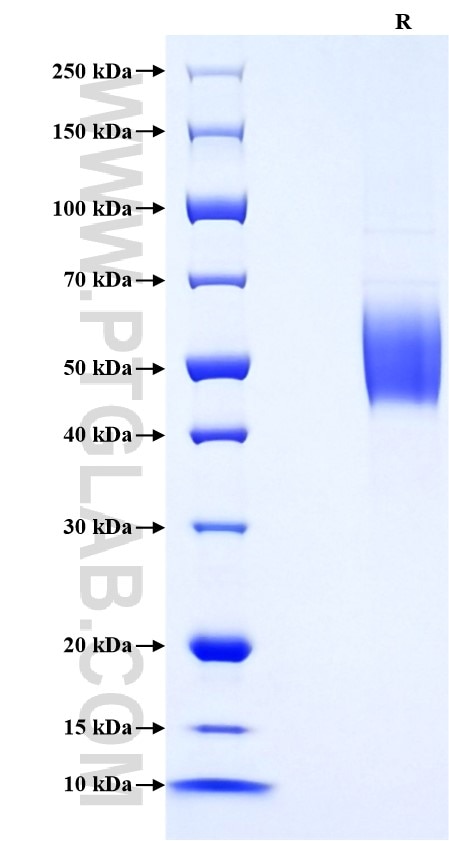Recombinant Human KLRG1 protein (rFc Tag)
Species
Human
Purity
>90 %, SDS-PAGE
Tag
rFc Tag
Activity
not tested
Cat no : Eg2036
Validation Data Gallery
Product Information
| Purity | >90 %, SDS-PAGE |
| Endotoxin | <0.1 EU/μg protein, LAL method |
| Activity |
Not tested |
| Expression | HEK293-derived Human KLRG1 protein Leu60-Phe195 (Accession# Q96E93-1) with a rabbit IgG Fc tag at the N-terminus. |
| GeneID | 10219 |
| Accession | Q96E93-1 |
| PredictedSize | 42.7 kDa |
| SDS-PAGE | 45-65 kDa, reducing (R) conditions |
| Formulation | Lyophilized from 0.22 μm filtered solution in PBS, pH 7.4. Normally 5% trehalose and 5% mannitol are added as protectants before lyophilization. |
| Reconstitution | Briefly centrifuge the tube before opening. Reconstitute at 0.1-0.5 mg/mL in sterile water. |
| Storage Conditions |
It is recommended that the protein be aliquoted for optimal storage. Avoid repeated freeze-thaw cycles.
|
| Shipping | The product is shipped at ambient temperature. Upon receipt, store it immediately at the recommended temperature. |
Background
KLRG1 (killer cell lectin-like receptor subfamily G, member 1) is a C-type lectin inhibitory receptor that contains an immunoreceptor tyrosine-based inhibitory motif (ITIM) in its cytoplasmic domain. KLRG1 is expressed by subsets of NK and T cells, existing both as a monomer and as a disulfide-linked homodimer. It is considered to be a cell differentiation marker for NK and T cells and is strongly induced by viral and other infections. Through interactions with members of the cadherin family, KLRG1 plays an inhibitory role on NK- and T-cell function.
References:
1. L Corral, et al. (2000) Eur J Immunol. Mar;30(3):920-30. 2. Yili Li, et al. (2009) Immunity. Jul 17;31(1):35-46. 3. Stipan Jonjic. (2010) Eur J Immunol. May;40(5):1241-3. 4. Stephan Rosshart, et al. (2008) Eur J Immunol. Dec;38(12):3354-64.

